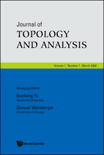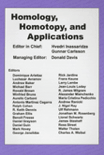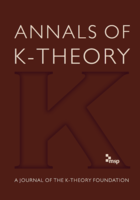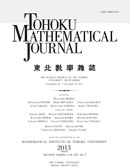
Quantum Topology
Scope & Guideline
Unraveling the Mysteries of Geometry through a Quantum Lens
Introduction
Aims and Scopes
- Knot and Link Homology:
The journal emphasizes research on homology theories that arise from knot and link invariants, exploring their algebraic structures and geometrical implications. - Topological Quantum Field Theories (TQFTs):
It publishes studies related to TQFTs, which provide a framework for understanding quantum invariants of manifolds and links, often employing advanced categorical techniques. - Mapping Class Groups and Their Representations:
Research on mapping class groups, which are pivotal in the study of surfaces and their invariants, is a core area, integrating algebraic and geometric aspects. - Categorification and Algebraic Structures:
The journal covers developments in categorification, where algebraic concepts are elevated to higher categorical levels, revealing deeper insights into topological properties. - Lagrangian Geometry and Floer Homology:
There is a consistent focus on Lagrangian submanifolds and their associated Floer homology theories, connecting symplectic geometry with topological invariants.
Trending and Emerging
- Advanced TQFT Invariants:
There is a growing trend in developing advanced TQFT invariants, particularly those derived from new algebraic structures, showcasing the rich interplay between topology and quantum theory. - Lagrangian and Symplectic Geometry:
Recent works increasingly explore the connections between Lagrangian geometry and knot theory, emphasizing its importance in understanding topological invariants through symplectic methods. - Categorification Techniques:
Emerging techniques in categorification are gaining traction, with researchers investigating their implications for knot invariants and topological structures, reflecting an innovative shift in methodology. - Link Homology and Ribbon Concordances:
A rise in interest in link homology theories and their applications to ribbon concordances indicates a deeper exploration of these connections within topology. - Representation Theory of Mapping Class Groups:
The representation theory of mapping class groups is becoming a focal point, as new representations and their applications to topological problems are being actively researched.
Declining or Waning
- Non-semisimple Invariants:
There has been a noticeable decrease in publications focused on non-semisimple invariants of 3-manifolds, suggesting a shift towards more refined and structured algebraic approaches. - Chern-Simons Theory:
Research specifically related to Chern-Simons functional and its applications to knot theory has waned, indicating a possible move towards other frameworks or methodologies. - Classical Knot Theory:
Papers focusing solely on classical aspects of knot theory without a quantum or categorical approach have become less prevalent, as the community increasingly embraces quantum methods.
Similar Journals

Journal of Topology and Analysis
Connecting Ideas in Topology and Analytical TheoryJournal of Topology and Analysis, published by WORLD SCIENTIFIC PUBL CO PTE LTD, is a distinguished peer-reviewed journal that focuses on advanced topics in mathematics, specifically within the fields of topology and analysis. Established in 2009 and running through 2024, the journal is based in Singapore and strives to present cutting-edge research that contributes to the mathematical community's understanding of geometric structures and analytical theories. Holding a respected position with a Q2 ranking in Analysis and a Q3 ranking in Geometry and Topology according to the 2023 category quartiles, the journal is indexed in Scopus, where it ranks #49 in Geometry and Topology and #118 in Analysis, showcasing its significance in the scholarly landscape. The Journal of Topology and Analysis aims to foster interdisciplinary collaboration by providing a platform for researchers, professionals, and students to share innovative findings and insights. Although it does not currently offer open access, its contributions are vital for advancing knowledge in these mathematical domains.

Homology Homotopy and Applications
Bridging Theory and Practice in Algebraic MathematicsHomology Homotopy and Applications is a prestigious peer-reviewed journal published by INT PRESS BOSTON, INC, dedicated to advancing the field of mathematics, particularly within the realms of algebraic topology, homological algebra, and their applications. With an impressive Q1 classification in the mathematics category for the year 2023, this journal serves as a crucial platform for researchers, professionals, and students aiming to disseminate their findings in a rapidly evolving discipline. Although open access options are not currently available, the journal retains significant value with its rigorous selection process and high-impact studies. The journal invites submissions that explore theoretical developments as well as practical applications that bridge homology and homotopy theories, thus contributing to the broader scientific community from its base in the United States. With convergence covering years from 2001 to 2024, Homology Homotopy and Applications continues to be a vital resource for fresh insights and groundbreaking research in mathematical sciences.

Cambridge Journal of Mathematics
Connecting Ideas to Shape the Future of MathematicsCambridge Journal of Mathematics, published by INT PRESS BOSTON, INC, is a premier platform for the dissemination of cutting-edge research in the field of mathematics. With an ISSN of 2168-0930 and E-ISSN 2168-0949, this journal stands out in a competitive academic landscape, currently ranked #58 out of 399 in General Mathematics, placing it in the top 15% within its category according to Scopus metrics. The journal serves as a vital resource for researchers, professionals, and students alike, aiming to foster groundbreaking mathematical inquiries and foster collaboration across disciplines. Published from 2020 to 2024, the Cambridge Journal of Mathematics is committed to maintaining high standards of scholarship, making it an essential read for those who are passionate about advancing mathematical knowledge and its applications.

Communications in Number Theory and Physics
Pioneering Research at the Confluence of Two DisciplinesCommunications in Number Theory and Physics is a leading academic journal published by INT PRESS BOSTON, INC, dedicated to the exploration of the intersections between number theory and physics. Since its inception in 2007, the journal has established a reputation for excellence, evidenced by its 2023 rankings placing it in the Q2 category within the fields of Algebra and Number Theory, Mathematical Physics, and Physics and Astronomy (Miscellaneous). With an ISSN of 1931-4523 and an E-ISSN of 1931-4531, the journal facilitates valuable peer-reviewed research, making substantial contributions to both theoretical and applied aspects of its core disciplines. Recognized for its prominence within the academic community, it holds notable Scopus rankings, highlighting its influence and quality of published work. Communications in Number Theory and Physics serves as an essential platform for researchers, professionals, and students, fostering scholarly dialogue and advancing knowledge at the intersection of mathematics and physics.

Annales de l Institut Henri Poincare D
Connecting Minds through Open Access ScholarshipAnnales de l Institut Henri Poincare D, published by the esteemed EUROPEAN MATHEMATICAL SOCIETY, is a notable open-access journal dedicated to advancing the fields of mathematics and physics. With an ISSN of 2308-5827 and E-ISSN 2308-5835, this journal has risen to prominence since its inception in 2014, benefiting from a significant level of accessibility since 2022. Based in Germany, it provides a rigorous platform for scholarly research in areas such as Algebra and Number Theory, Discrete Mathematics and Combinatorics, Geometry and Topology, Statistical and Nonlinear Physics, and Statistics and Probability, where it has achieved a Q1 quartile ranking in 2023. With its Scopus ranking reflecting excellent percentile standings, particularly in Algebra and Geometry, Annales de l Institut Henri Poincare D is essential reading for researchers and academics seeking to engage with cutting-edge developments and innovative methodologies in their respective fields. Researchers can find it valuable not only for its high-quality publications but also for its commitment to fostering a global knowledge exchange in mathematics and physics.

Annals of K-Theory
Bridging Theory and Application in MathematicsAnnals of K-Theory, published by Mathematical Science Publishers, is an esteemed academic journal that serves as a vital platform for advancing research in the fields of analysis, geometry, and topology. Since its inception in 2016, the journal has successfully merged rigorous mathematical exploration with practical application, catering to a diverse audience of researchers, professionals, and students. With an impressive track record as a Q2 journal in Analysis and Geometry and Topology, and achieving a Q1 ranking in Assessment and Diagnosis in 2023, Annals of K-Theory continues to be recognized for its significant contributions to the mathematical sciences community. Although currently not open access, the journal provides relevant and accessible content that encourages rigorous dialogue and collaboration among mathematicians. As indicated by its Scopus rankings, it holds a commendable position within its field, demonstrating a commitment to quality research that pushes the boundaries of mathematical knowledge and application.

Pure and Applied Mathematics Quarterly
Elevating Research in Pure and Applied MathematicsPure and Applied Mathematics Quarterly is a prestigious journal published by INT PRESS BOSTON, INC, focusing on the diverse and evolving field of mathematics. Since its inception in 2007, this journal has grown significantly, currently holding a Q1 ranking in the Mathematics (Miscellaneous) category for 2023, positioning it among the leading publications in the discipline. With a commitment to publishing high-quality research, Pure and Applied Mathematics Quarterly fosters innovation and dialogue within the mathematical community by providing a platform for theoretical advancements and practical applications. The journal remains accessible to researchers and professionals through its ISSN 1558-8599 and E-ISSN 1558-8602, although it does not currently offer open access. As a vital resource for mathematicians, educators, and students, this journal endeavors to expand the frontiers of mathematical knowledge and contribute to the academic dialogue surrounding this fundamental science.

Revista Matematica Complutense
Pioneering Insights in the Field of MathematicsRevista Matematica Complutense is a prestigious peer-reviewed journal published by SPRINGER-VERLAG ITALIA SRL, specializing in the field of mathematics. With its ISSN 1139-1138 and E-ISSN 1988-2807, the journal plays a vital role in disseminating high-quality research and fostering academic discussion within the mathematics community. Recognized for its rigorous selection process, the journal has achieved impressive rankings, holding a Q1 quartile status in the miscellaneous mathematics category as of 2023 and ranking #94 out of 399 in general mathematics according to Scopus, placing it within the 76th percentile. With a publication timeline spanning from 2008 to 2024, the Revista Matematica Complutense continues to serve as an essential resource for researchers, professionals, and students alike. Although it does not currently offer open access, the journal remains committed to advancing mathematical knowledge and providing a platform for innovative research across various mathematical disciplines.

Methods of Functional Analysis and Topology
Unlocking the complexities of mathematical landscapes, one method at a time.Methods of Functional Analysis and Topology is a distinguished open-access journal published by INST MATHEMATICS, based in Ukraine. Fostering a scholarly environment since 2006, this journal serves as a vital platform for researchers and practitioners in the fields of functional analysis, topology, and mathematical physics. Despite its Q4 ranking in key categories such as Analysis, Geometry and Topology, and Mathematical Physics as of 2023, the journal addresses a growing need for accessible research and dialogue within these domains. With ISSN 1029-3531, it marks a commitment to advancing knowledge in mathematics, ensuring that innovative ideas and methodologies can reach a broader audience. As scholars continue to explore complex mathematical concepts, Methods of Functional Analysis and Topology stands as an integral resource, encouraging collaboration and understanding amidst the diverse landscapes of mathematics.

TOHOKU MATHEMATICAL JOURNAL
Unraveling the Complexities of Mathematics TogetherTOHOKU MATHEMATICAL JOURNAL, published by TOHOKU UNIVERSITY, is a distinguished academic journal committed to the advancement of mathematical research. Established in 1949, the journal has sustained a long-standing tradition of disseminating high-quality, peer-reviewed articles that contribute significantly to various branches of mathematics. With its scope encompassing a broad range of topics within the field, TOHOKU MATHEMATICAL JOURNAL aims to foster intellectual exchange and innovation among mathematicians worldwide. Though currently not an open-access publication, it is indexed in Scopus, holding a respectable Q2 ranking in the miscellaneous mathematics category as of 2023, which signifies its relevance and influence in the academic community. Researchers, professionals, and students alike will find valuable insights and contemporary developments that reflect the journal's dedication to excellence in mathematical scholarship.